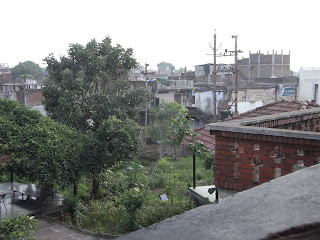And now for the good news – at least
some of it.
I
went to Sambhavna in Bhopal in August 2011. Over the years since 1984 I have
remembered the explosion in Bhopal, I don’t know why, but it has often popped
into my consciousness over the years when some news report sneaked out. In
early 2010 I was looking for a greater challenge than a few clients in Warwick
and out of a copy of New Internationalist fell a leaflet for the Bhopal Medical
Appeal (BMA), a UK charity.
The
BMA was formed in 1994 When a group of concerned individuals placed an advert
in the Guardian, a UK daily newspaper, on the date of the 10th
anniversary. Within a week enough was raised to purchase a building in Bhopal
and create the Sambhavna Trust Clinic.
It was the fourth attempt by volunteer
survivor organisations in Bhopal to set up a medical centre. Both state and
national government in India had ignored the recommendations of the
International Medical Commission on Bhopal (ICMB). It was 1996, less than two
years after that advert, that the clinic opened to local people. One person,
crucial to its creation, was Sathyu Sarangi, mentioned in a previous blog was appointed
managing trustee, a post he still fills. It moved to its current location in
2006.
The
whole emphasis was on the possibility of healing with compassion. One meaning
of the word Sambhavna is ‘possibility’. A beacon of light appeared as there was
still much despair in the community – still suffering.
Despite
being a tiny prick in the magnitude of the problems – even today there are over
100,000 survivors still chronically ill – it represented a truly local and
‘people first’ approach and proved it was possible to evolve simple, safe,
effective, ethical and participatory treatments, including monitoring and
research. To date some 45,000 people have passed through its doors and probably
a similar number have benefited from the outreach programmes and health
initiatives. And Sambhavna continues to innovate to bring new ideas to
treatment and support.
The
ICMB had seen an important role for community clinics in discouraging expensive
drug treatments with potentially harmful side effects over the long-term. It
was already anticipated that some survivors would need to be on some form of
medication for the remainder of their lives. Though they could not see beyond
allopathic approaches.
The
doctors at Sambhavna could, however, and wanted to use natural and traditional
Ayurveda approaches including yoga, massage (panchkarma) diet and meditation as
part of their healing methods. So they set up a centre where the allopathic and
traditional could work side-by-side. It is worth noting, for the non-Indian
readers, that all doctors in India must train in the standard modern systems
and THEN go on to study Ayurveda.
Even
today the four doctors* will still share their knowledge and skills and the
hi-tech pathology lab serves them all as does the pharmacy where the staff
distribute allopathic medicine and herbal remedies.
Almost all of the herbal treatments
are grown within the acre or so (about half a hectare) of garden and produced
in the adjacent small manufacturing unit. There is a walk around the garden on
my youtube channel at http://www.youtube.com/watch?v=GvDpVtB_3ZM
The
garden staff are experts in their field and can often be seen giving advice to
patients on growing their own plants and preparation of tisanes etc. They also
provide all the 23 herbs that go in the special panchkarma oil for the body
therapy treatments.
Many
of the staff working at the clinic are themselves survivors from the gas explosion
and water pollution, and some of their stories are told in The Bhopal Marathon
(www.bhopalmarathon.com). This
gives them an added sense of loyalty and care for their own community.
The team at Sambhavna has also been in the forefront of research, especially into the use of Ayurveda herbal remedies used over the long-term. Sambhavna has won several international awards for this work. There are difficulties, however, as it is hard to find a research lab in India that is not open to corruption.
The team at Sambhavna has also been in the forefront of research, especially into the use of Ayurveda herbal remedies used over the long-term. Sambhavna has won several international awards for this work. There are difficulties, however, as it is hard to find a research lab in India that is not open to corruption.
The
really important difference between Sambhavna and the many government hospitals
(as well as those in most other countries!) is the patient focus. It might be
described as ‘patient first’. Everyone is given the same courtesy and respect,
whether they live on the street and arrive ragged and unkempt or they are smart
and live in a house. One client commented, “a good doctor is one whose kind
manner alone removes 50% of the illness.” There is no caste distinction nor
religious discrimination. One innovation whilst I was there was the creation of
a patient group, where representatives of the community meet with Sambhavna
staff to discuss matters of praise and concern and to develop new methods of
working. It was already bearing fruit in the decision making.
One
of the volunteer health workers, herself with two stillborn, deformed babies,
has said that “ the happiness of selfless service is greater than all happiness.
In each other we find strength and the joy of friendship. Yes, we are poor,
but, working together, we can achieve unimaginable things.”
*two working mainly with allopathic approaches and two mainly with
Ayurveda. There is also a gynaecologist




Hi Ian
ReplyDeleteThe people you speak of seem so positive and up for helping themselves, it is inspiring.
love Sharon